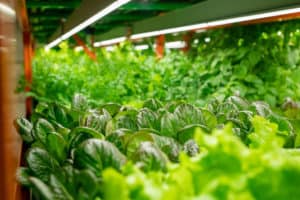Vertical farming has proven to be very effective in providing freshly grown leafy greens and herbs to heavily urbanized areas. However, what can be grown on a vertical farm is strongly driven by two crucial factors: economic and biological viability.
Technically vertical farming allows the cultivation of all kinds of vegetables and herbs, including medicinal plants. However, not every crop is economically viable to grow. Hence, farmers have to answer whether they should grow the crop based on their individual situation.
However, by expanding their product range, vertical farmers may encounter various barriers, leading to higher production costs. Will vertical farmers overcome these challenges and move beyond the production of leafy greens and herbs? Let’s look at this problem more closely.
Why Herbs and Leafy Greens Are the Best for Vertical Farming?
Traditionally, leafy greens and herbs have always been associated with indoor agriculture and continue to be extremely popular among vertical farmers. A 2017 report of WWF on indoor agriculture revealed that 57% of indoor and vertical farms produce leafy greens. Some of the most commonly grown herbs and veggies in vertical farms are basil, lettuce, chards, chives, kale, collard greens, mint, and bok choy
There are several reasons why vertical farmers prefer to grow leafy greens and herbs over other vegetables. Let’s look at some of them in greater detail.

Easy to Grow and Require Less Space
Leafy greens such as lettuce, kale, swiss chard, and spinach are easy to grow in vertical systems, as they require little space and are ready to harvest within a few weeks. To maximize space, farmers usually stack leafy greens on top of one another.
Furthermore, if harvested properly and watered regularly, these vegetables can renew their leaves, allowing for a second and a third harvest. Not only does this reduce additional costs, such as frequent seed purchases, but it also enables farmers to sell high-quality produce all year round.
Huge Part of the Plant Can Be Sold
Cash crops, such as tomatoes and eggplants, are usually grown for their fruits. When the harvest season is over, the remaining parts of the plant (which can be significant in size) are disposed of or up-cycled. With leafy greens, on the other hand, vertical growers can sell a huge part of the plant, so not much of it gets wasted. This eliminates extra costs (especially energy) and time-consuming tasks such as the proper disposal of plants or composting.
Great Variety and Consistent Demand
There are many edible varieties of leafy greens and herbs, which require similar growing conditions. There are at least four commercially available lettuce varieties: romaine, butterhead, iceberg, and curly leaf. Also, basil comes in many different types, including the famous Genovese basil and Greek dwarf basil.
The demand for vertically grown leafy greens and herbs is constant throughout the year. In 2020 it increased significantly due to the Covid-19 pandemic. The traditional food supply chain systems were hindered by the pandemic, leading to an increase in demand for locally grown crops.
Given the increasing popularity of vertically grown products, it is important for farmers to not keep all of their eggs in one basket and be prepared to offer their clients a wider range of products.
 Shop The Farmstand – Self-Watering, Self-Fertilizing Solution for an Easy to Grow Harvest
Shop The Farmstand – Self-Watering, Self-Fertilizing Solution for an Easy to Grow Harvest
Crops Theoretically Possible to Grow in Vertical Farms
Peppers, aubergines, cantaloupes, strawberries, mushrooms, and pumpkins are just some of the countless vegetable cultures that can be grown in vertical farms. The cultivation of these crops poses various technical and economic challenges for vertical farmers. Some of these issues can be easily addressed by adjusting existing vertical systems, while others require substantial changes.
For instance, eggplants and pumpkins produce heavy fruits that can be damaged when grown in vertical systems. An issue that farmers can solve by incorporating grow cages or support platforms in their vertical farms.
Another critical issue is pollination. Vine crops require insect pollination to produce fruits, which is not possible in indoor agriculture. As a result, vertical farmers have to hand-pollinate these plants or apply blossom set sprays.
In addition to the crops mentioned above, vertical farming also provides a solid and healthy foundation for the growth of medicinal plants. Controlled growth conditions and a regular supply of nutrients are known to boost the secondary metabolism of these plants. Some medicinal plants such as echinacea and basil, when grown in hydroponic systems, responded very well to these conditions as they grew rapidly and built up large biomass in a short time.
Vertical farming promises to provide pharmaceutical companies a constant supply of high-quality medicinal plants year-round without endangering or depleting their natural populations.
Biological Viability vs. Economic Viability
As I mentioned at the beginning of this article, economic and biological viability are two crucial factors that can either make or break the success of any vertical farm.
Biological viability describes the ability of plants to survive, grow, and reproduce under specific growing conditions. When cultivated indoors, plants must adapt to substantial changes in photoperiod, light intensity, temperature, and most importantly, the lack of soil. So, in short words, this is just the technical ability to grow plants in a particular environment. In our case – the indoor environment.
On the other hand, economic viability refers to the expected benefits and financial success from implementing a given project. Vertical farming requires high upfront investments and maintenance costs that seriously undermine its economic viability.
Keeping this difference in mind, we can see that not every crop that can be grown indoors is economically viable. Hence, farmers should be cautious and always consider the financial sustainability of their farms when deciding on which crops to grow.
For example, crops like rice and corn, despite constant demand and the possibility to be grown in an indoor environment, are not compatible with vertical farming. At first, they require a lot of space. Moreover, a vast part of the plant is not edible, so a lot of light energy needed to grow this part would be wasted.
Economical Viability of Different Types of Crops
Before embarking on a vertical farming journey, every farmer and investor must examine various indicators to assess the economic viability of the crops they are going to grow. Market demand, local climate, and the techniques necessary for the cultivation of these crops should be carefully studied. As they have the potential to severely hinder the economic viability of these farms. In this section, let’s look at the economic viability of the main types of crops that could potentially be grown in vertical farms.
Leafy Greens
Leafy greens are now a constant ingredient of the diet of many people worldwide, so the market demand for them is fairly constant all year round. They are not demanding to grow in vertical systems, have a quick turn, and require little space to grow in. Moreover, as there are many varieties of leafy greens, farms can diversify their product range and increase their profits at the same time.
Herbs
Similar to leafy greens, herbs are also very popular and have a steady demand throughout the year. When cultivated under controlled conditions, herbs grow much easier and faster than they do outdoors. That allows farmers to sell them all year round, making them more economically viable.
Root vegetables
Root vegetables like carrots and beets can be successfully cultivated in hydroponic systems, but growing them indoors is much more challenging than with leafy greens or herbs. To grow normally, they require a constant supply of nutrient water or growing medium and a lot of space. And they need up to 16 hours of light per day. These demands increase farmer’s production costs significantly, making them economically unsustainable. At least for now.
Fruiting Crops
Fruiting crops are also very demanding when grown indoors. They need insect pollination to produce fruit, and special support platforms are needed for their fruit. More space is required for proper plant development. Special attention should be given to temperature changes and light intensity as they may hamper their growth. Fruit crops such as eggplants have a slow turn, as it takes 120 days to harvest, and they are also more susceptible to diseases than leafy greens. There is also a fluctuation in demand during the year. Despite these challenges, there are already vertical farms that produce fruiting crops like strawberries and sell them with profit.
Grains
Vertically grown grains are not commercially available because of the large quantities of space, water, and energy required for their growth. These demands drive up the costs of production for vertical farmers. With the current technology used in vertical farming, grain production is not economically sustainable at all.
What Needs to Happen for More Crops to Be Economically Grown in Vertical Farms
At present, vertical farming is an attractive solution for countries that face pressing challenges such as land scarcity and depleting natural resources. However, due to the significant initial capital required for its construction and maintenance, vertical farming is more popular in those regions and countries with the means to invest in this sector.
Governments need to adapt their agricultural policies to increase support for vertical farmers. Increased funding would attract potential investors, while subsidies would help existing vertical farmers reduce their production costs. Singapore is one of the first countries globally where the government closely collaborates with vertical farms to implement new policies to facilitate their production.

More research is essential in developing new methods to reduce the initial and maintenance costs and increasing production efficiency.
Moreover, local governments should offer direct funding to vertical farmers so that they can lower the prices of their products to remain competitive. Traditional farmers already benefit from direct subsidies that allow them to sell their products for less, making it difficult for vertical farmers to compete with them. Overall, governments should be the main supporters of vertical farming by boosting investments and increasing funding.
Conclusion
Taking everything into consideration, vertical farming certainly has the potential to produce a greater variety of crops and go beyond the production of just leafy greens and herbs. Due to high production costs and the unique needs of some crops, this change is currently economically unsustainable. However, as technology and agriculture move forward, the expansion of their product line will definitely be a reality in the near future.
To get started growing these crops is not as hard as you may think. In fact you can do it at home for just over $100. I can tell you how, if you would like. You would? Great! I recommend this complete set, and these heirloom seeds. Seriously read the reviews, and tell me what you think! Happy Farming, Folks!
